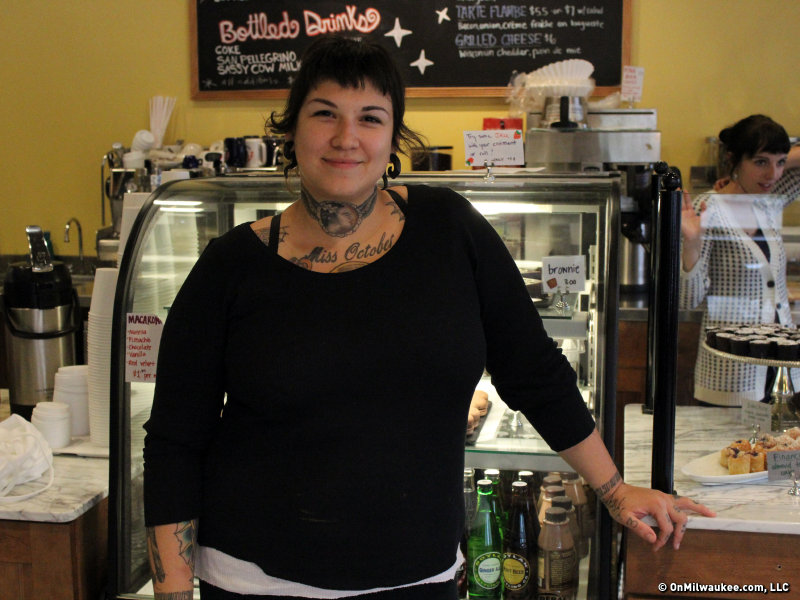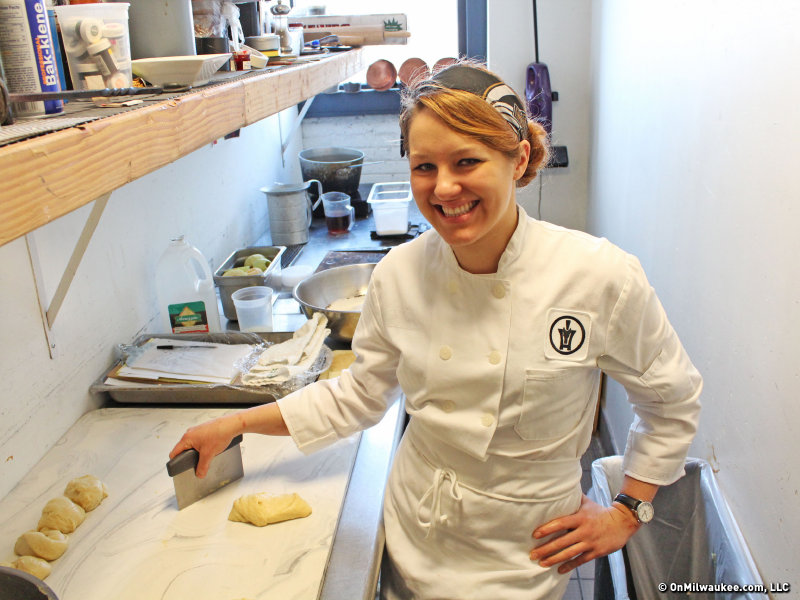If you haven’t had the pleasure of meeting Chef Kurt Fogle, pastry chef for the SURG Restaurant Group, it’s tough to describe what a massive repository of pastry knowledge exists in the brain behind his unassuming baby faced exterior. But, suffice it to say, Fogle is a force to be reckoned with.
This Racine native began his career at a young age, working behind the scenes for Racine’s O&H Danish bakery. As he worked, tirelessly packing donuts neatly into their boxes, he knew he wanted more.
"I wanted to frost the donuts," he told me as we sat in his basement kitchen space beneath Umami Moto.
I chuckle to think of him, as a young boy with those big frosting dreams. And I smile to think that he’s now in charge of not only frosting the donuts, but making them from scratch, along with a cadre of other delicious pastries and desserts served at some of the best restaurants in Milwaukee.
Needless to say, I was pretty happy to sit down with him and get his perspective on what it’s like to be a pastry chef, what he’s currently working on, and what tips he has for home cooks looking to take their baking to the next level.
OnMilwaukee.com: Where did your relationship to sweet treats begin?
Kurt Fogle: Well … my mom was a terrible cook. At our house she’d be making something for dinner and I’d be disgusted or whatever. ‘If you want something else, make it yourself,’ she’d say. And so I did. My mom has become an excellent cook since then.
After working at O&H for a while, I had the opportunity to be a dishwasher at a place called Swingers in Racine. There were some cooks there who had been there for a long time. I remember we were always tasting the soups. And that was cool. But, every night I was there, I just begged them to show me something more. Unfortunately, it wasn’t legal for me to help prep anything until I turned 18 and could wield a knife. But, they let me play around in the kitchen, and that was my first real exposure to making restaurant food.
OMC: So you had big dreams?
KF: Yeah, I wanted to open a restaurant called Chubby’s that served like five-pound cheeseburgers, chicken sandwiches with like four chicken breasts … buckets of fries. Totally abundant and not expensive. I dreamed of running a fast food place. There was something about the efficiency and cleanliness of it.
OMC: So, how did you end up in pastry?
KF: On the outside I’m a pastry chef. On the inside I’m just a guy who wants to know everything about food.
I don’t want to get to the end of my life and not have my own recipe for mayo. I like the fact that I have cool outlets here for both savory and sweet – like family meal where I get to play around with concepts and master new things.
But, as far as how I got to pastry … it is dependent more on accuracy. So, I thought that if pastry was the more exact science, I would learn that first and it would give me an opportunity to approach savory from a scientific perspective. I just never moved further than that.
OMC: How does the process work for creating a restaurant’s dessert menu?
KF: It starts with the chef. The first thing I consider is how they approach food, and then I look through their menu, taste as much as possible and design things I’d want to eat at the end of their menu. Because the chefs have their own stamp on things, I ask them what they want to see on their menu. Depending on the feedback I get from them, I go from there.
For instance, Carnivore is a classic American place. That’s why the chocolate mousse has graham crackers and marshmallow, because nothing is more quintessential than the s’more.
OMC: So, you pretty much stick with a theme for each restaurant?
KF: Well, yes and no. When I first started, I had very vivid lines drawn for each restaurant. But, the thing that seems like it’s happening around the world is that there are these similarities. Everyone has cake, there’s custards, there’s fruit and nuts.
The Dreamsicle being designed as a classic American dessert and then being transferred over to Umami Moto … that’s a good example of something that really transferred over from one concept to another. Maybe not the name so much, but definitely the flavors.
OMC: I’ve been writing this series on the lost arts in pastry. What do you see coming back from the old ways?
KF: Guys like Geoff (Trenholme) and Matt (Haase), Justin (Carlisle) and Jarvis (Williams), who are pushing the envelope while looking backwards. What they’re doing is steeped in tradition. Things used to be really good. Everything is based on classic techniques.
OMC: Do you see resurgence in restaurants hiring pastry chefs?
KF: I think now they’re trying to figure out a way to make it work. Most small restaurants don’t have the budget to hire a pastry chef. So, there aren’t a lot of places that necessarily have one.
The first thing we tell MATC students coming through is… if you want to work in a restaurant, you’ll have a restaurant job where your specialty is dessert. You have to be willing to do other things.
OMC: What classic techniques are you working to master?
KF: Everything. The philosophy is if we can make it better, we do. At the current moment, I’m working on truffles. Chocolate is way more difficult to deal with than people think.
I’m always looking at ways to use new techniques to make old school things better. For example, we found a better way of making mousseline by using agar. We’re not using it because it’s cool and new. It just works better than corn starch. We’re not trying to make things that are all smoke and mirrors.
OMC: Where would you place yourself on the continuum of classic to innovative?
KF: Smack dab in the middle. Everything that’s done is based in classic French techniques; it’s all steeped in tradition, but I’m always looking at ways to improve upon a good thing.
OMC: Who are your biggest influences?
KF: Jacquy Pfeiffer and Sébastien Canonne from the School of French Pastry for their adherence to quality – doing things the right way. Geoff Trenholme and Matt Haase at Rocket Baby for sure, for their drive for excellence.
OMC: What’s one of your favorite things you’re working on right now?
KF: Vanilla ice cream. Truffles. Figuring out how to make hot fudge without high fructose corn syrup and all that garbage.
OMC: In your work, what ingredient is currently over-used?
KF: The non-functional garnish is a pet peeve of mine. If it doesn’t fit with the dessert, then don’t put it out there. Mint leaves are such a waste. If you’re doing a mint dessert, then use them. Mint is beautiful. But, if you’re putting something on a plate for color, you’re kind of an asshole.
Oh – and unnecessary things. Things that are just for show. The people who made bacon ice cream. It gave them the advantage to look to their peers and feel like they were trendy, forward thinking. But, it just ended up tasting like bacon.
Ultimately, I want people to make food with passion. I don’t want people doing things they don’t believe in.
OMC: What ingredient should be used more often?
KF: Salt. I put salt in my chocolate milk. Cereal. I love cereal; I could put it in everything. Overall, people need to have more fun.
OMC: Are there dishes you’d love to make but suspect people wouldn’t order?
KF: Chocolate croissants, brioche, chocolate chip cookies. I get to make cookies every now and again, but I’m beyond the point where I can put a brownie on a plate and have it be OK.
I don’t really get to do any of the bakery stuff in my work, so I make those for my own benefit.
OMC: Let’s talk about home cooks. What is one technique they should be respecting that would change the way they operate in the kitchen?
KF: Whipping cream. You never whip cream on high, always medium. Do you know why? When you beat it on medium speed, you develop a stable foam, a stable matrix of fat, water, air. There’s no stability when you whip cream on high. You get too many differently sized molecules. At medium speed all the bubbles are the same size.
Sure, you can whip your cream very quickly if you want to put it on a piece of pie and eat it. But, if you want to make it ahead of time, you have to respect the process. And what’s the big hurry anyhow?
Also – switch to the metric system in the kitchen. If you want your cookies to have a snowball’s chance in hell of coming out the same, make sure you’re starting with the same amount of flour and sugar every single time. Buy yourself a scale and weigh your ingredients. If you trust that the butter company is really giving you 16 ounces of butter when you buy a pound, you’re wrong. Weigh that pound of butter.
A scale costs $20. And it will make your recipes better.
As a passionate champion of the local dining scene, Lori has reimagined the restaurant critic's role into that of a trusted dining concierge, guiding food lovers to delightful culinary discoveries and memorable experiences.
Lori is an avid cook whose accrual of condiments and spices is rivaled only by her cookbook collection. Her passion for the culinary industry was birthed while balancing A&W root beer mugs as a teenage carhop, fed by insatiable curiosity and fueled by the people whose stories entwine with every dish. Lori is the author of two books: the "Wisconsin Field to Fork" cookbook and "Milwaukee Food". Her work has garnered journalism awards from entities including the Milwaukee Press Club. In 2024, Lori was honored with a "Top 20 Women in Hospitality to Watch" award by the Wisconsin Restaurant Association.
When she’s not eating, photographing food, writing or planning for TV and radio spots, you’ll find Lori seeking out adventures with her husband Paul, traveling, cooking, reading, learning, snuggling with her cats and looking for ways to make a difference.





